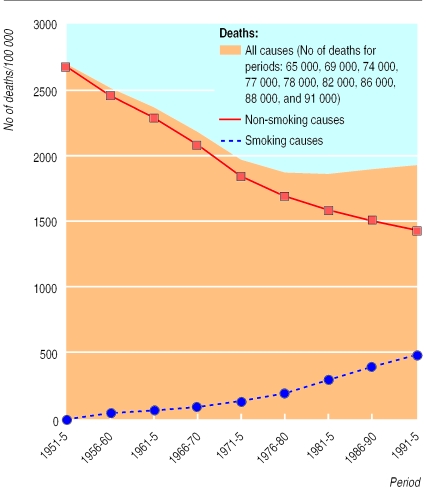Even at the beginning of the 1950s, the prevalence of smoking among Danish women was as high as 40%.1 In the 1980s the proportion of men and women who smoked cigarettes in Denmark was almost the same, which is unusual. Data from interviews and questionnaires showed that the proportion of heavy smokers had increased steadily among women over a long period: 1% (1953), 7% (1970), 12% (1980), 15% (1987), and 18% (1994). At the beginning of the 1990s, Danish women had the highest prevalence of smoking in the 87 countries in which smoking among women was recorded.2 The life expectancy of Danish women is shorter than that of women in other western European countries.3 Mortality from lung cancer and chronic obstructive pulmonary diseases among Danish women has increased greatly from the 1960s and is now by far the highest in Europe.3 To assess the impact of smoking on mortality among Danish women, we performed a register based study for the period 1951-95.
Methods and results
We calculated mortality attributable to tobacco use by Peto et al's method.4 They compared the death rates from lung cancer in a study population with those of a US group to derive an estimate of smoking rates in the study population (more lung cancer meant more smoking). They assumed that certain relative risks for smoking and important diseases related to smoking applied to all populations. These two sets of assumed statistics were then used to calculate population attributable risks for each of the major causes of death in each population.
Data on deaths and causes of death in Denmark are available in the Cause of Death Register of the National Institute of Public Health, which covers all deaths in Denmark since 1943. The data on deaths in other countries of Europe were derived from the World Health Organization's database.
The figure shows the risk of death among Danish women aged 55-84 since the beginning of the 1950s. The risk of mortality from any cause declined until the start of the 1970s and then increased slightly. In the absence of deaths attributed to smoking, the decline would have continued. The risk of dying of tobacco attributed causes increased steadily, from less than 1% of all deaths at the beginning of the 1950s to about 25% of all deaths 40 years later.
Comment
Since the 1970s, Danish women in some age groups have experienced increasing numbers of deaths. This can be explained by the longstanding heavy use of tobacco.
The risk of dying of causes attributed to tobacco is still highest among men, but it is the trend among women that is of most concern. Denmark is one of the few countries in which the estimated annual mortality from smoking is almost identical for men and women.
No country has yet experienced the full impact of smoking on women's health,5 but there is now strong evidence that when women have smoked cigarettes regularly for several decades the percentage of deaths attributable to tobacco approaches that of men.4 This situation has almost been reached in Denmark, and the trend may be a forerunner of a development that has begun or will begin in other European countries.
Danish life expectancy cannot be improved greatly without a substantial reduction in tobacco consumption. Furthermore, the present high proportion of smokers among adult Danes will continue to affect the mortality pattern far into this century. Clearly, if it were not for tobacco, Danish women would have experienced a considerable reduction in mortality.
Figure.
Trends in age standardised mortality (per 100 000, world standard) for deaths attributed to smoking and to causes other than smoking among women aged 55-84 in Denmark, 1951-95
Footnotes
Funding: The study was supported by grants from the Danish Ministry of Health.
Competing interests: None declared.
References
- 1.Hamtoft H, Lindhardt M. Tobacco consumption in Denmark. Dan Med Bull. 1955;2:213–220. [PubMed] [Google Scholar]
- 2.World Health Organization. Tobacco or health. A global status report. Geneva: World Health Organization; 1997. [Google Scholar]
- 3.Juel K, Bjerregaard P, Madsen M. Mortality and life expectancy in Denmark and in other European countries: what is happening to middle-aged Danes? Eur J Public Health. 2000;10:93–100. [Google Scholar]
- 4.Peto R, Lopez AD, Boreham J, Thun M, Heath C. Mortality from tobacco in developed countries: indirect estimation from national vital statistics. Lancet. 1992;339:1268–1278. doi: 10.1016/0140-6736(92)91600-d. [DOI] [PubMed] [Google Scholar]
- 5.Amos A. Women and smoking. Br Med Bull. 1996;52:74–89. doi: 10.1093/oxfordjournals.bmb.a011534. [DOI] [PubMed] [Google Scholar]



